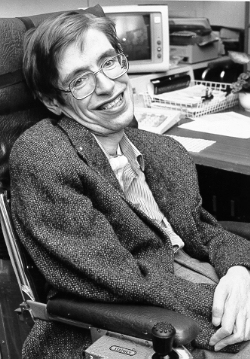Stephen Hawking, a renowned cosmologist and celebrity scientist, passed away at age 76 on March 14, 2018, the 300th anniversary of Galileo’s death. Hawking was born in Oxford, England in 1942 to a family of academics: his mother studied politics, philosophy, and economics and worked as a secretary for a medical research institute, and his father was a medical researcher who later became head of the division of parasitology at the National Institute for Medical Research. Bored by his early schooling, Hawking nonetheless graduated in 1962 with a First-Class BA degree in physics from University College, Oxford, as his preferred subject of study, mathematics, was not offered as a degree.
Hawking then moved on to study physics at Trinity College, Cambridge. He intended to study under Fred Hoyle, a renowned physicist at the time, but Hoyle – a celebrity in the physics community – did not have room to take on another student. Instead, Hawking was placed under Dennis Sciama, a less famous but extremely well-respected cosmologist. This turned out to be a blessing in disguise; while Hoyle was more often at conferences than in his office, Sciama was usually available to discuss with and guide his students. In an obituary of Hawking by Robert Penrose, with whom Hawking collaborated closely later in his academic career, Penrose claimed that Sciama “conveyed infectious excitement to all who encountered him.” This excitement was passed on to Hawking, who seemingly no longer struggled to engage with his work.
Sciama was not the only force behind Hawking’s newfound vigor. In 1963, shortly after his 21st birthday, he was diagnosed with the progressive neurodegenerative disease known as amyotrophic lateral sclerosis, or ALS. “Before my condition was diagnosed, I had been very bored with life,” Hawking said to an audience of disabled students at Seattle University in 1993. “There had not seemed to be anything worth doing.” While others may have been disheartened by this news – as well as the prognosis that he had only two to three years left to live, not even enough time to complete his PhD – Hawking was energized and poured himself into his work.
During Hawking’s second year of study at Trinity College, both he and Penrose, an English mathematician, were working on mathematical proofs describing how the collapse of a massive star would create a black hole, a region of space so enormously dense that almost nothing can escape.
Since nothing can travel faster than light, anything past this point cannot escape and is trapped forever.
Pop culture has lied to us; these black holes are not massive sucking machines. Gravitationally, they behave in the same ways that any other body of the same mass does, exerting an attractive force on other bodies proportional to their mass and inversely proportional to the square of their distance from the black hole. The difference arises once infalling material crosses the event horizon, the radius at which the escape velocity exceeds the speed of light. Since nothing can travel faster than light, anything past this point cannot escape and is trapped forever.
At the center of a black hole is a singularity, a point of infinite density and thus gravity where space-time curves infinitely and General Relativity fails. Penrose’s previous work had proved that the creation of a black hole must lead to the formation of a singularity. Hawking took this idea and generalized it, proving mathematically that singularities can form independently of black holes and are in fact an inevitable feature of General Relativity. Based on this, Hawking claimed that the very beginning of the universe, the Big Bang, was itself a singularity, formed not through the collapse of a star and the subsequent creation of a black hole, but through some other process that is not yet understood. In 1970, the two collaborated on the publication of these findings in Singularities of Gravitational Collapse and Cosmology, considered the first of Hawking’s true landmark papers.
In 1974, Hawking shocked the physics world with his publication Black Hole Explosions?, which claimed that black holes are not perfectly black after all. At all times, in apparently empty space, particle-antiparticle pairs are constantly coupling and decoupling, popping in and out of existence. If this occurs just outside the event horizon, then it is possible that one particle falls below the event horizon and forever out of sight, causing its partner to ricochet into space. In short, black holes can in certain conditions emit particles, which means they can lose mass – and thus energy – over time, eventually dissipating away.
Hawking claimed that the very beginning of the universe, the Big Bang, was itself a singularity.
While this was an exciting proposal, it introduced a new puzzle for cosmologists to solve, one Hawking was working on in the time leading up to his death. Quantum mechanics is based on probability. Instead of pinpointing the exact behaviors of particles, as is the approach in classical mechanics, we instead work out a likelihood of any given outcome. Probabilities are only meaningful when you can add up the likelihoods of all possible events and get a sum of one. When information is missing, the probability assigned to any given outcome is arbitrary and no longer tells you anything useful about the possible behaviors of the given system. If black holes were entirely black and did not decay over time, then there would be no problem when material fell into a black hole; that infalling material is hidden from view by the event horizon, but its information is intact. The dissipation of a black hole as a result of Hawking radiation is equivalent to the erasure of this information, which creates a very tricky problem indeed. This case of disappearing information, referred to as the information paradox, held Hawking’s fascination until his passing and continues to puzzle the physics community.
Hawking published his first book A Brief History of Time in 1988. It rapidly ascended to bestseller status, gaining popularity due to its cogent explanations of complex topics such as the origins and evolution of the universe. As readership of his book grew, Hawking graduated from renowned cosmologist to celebrity scientist and household name. His image became synonymous with science, with genius, with the stars. “Not since Albert Einstein has a scientist so captured the public imagination and endeared himself to tens of millions of people around the world,” Michio Kaku, a professor of theoretical physics at the City University of New York, said in an interview with the New York Times. Hawking rather enjoyed his newfound celebrity, taking to it with unexpected humor, which only increased his popularity. While he enjoyed – and was good at – being a visible icon of science, he was also a skilled science communicator and went on to publish several more successful books and give a large number of public lectures, several of which are transcribed on his website.
“Not since Albert Einstein has a scientist so captured the public imagination and endeared himself to tens of millions of people around the world.”
It’s a classic story: an extraordinary individual, faced with seemingly insurmountable obstacles, who through some combination of adequate support and steely will is nonetheless able to achieve extraordinary things. Hawking was told his life would end before he completed his PhD. He outlived his prognosis by 55 years, going on to become one of the most celebrated minds of his era. He authored over 200 publications, counting both books and academic papers; held thirteen honorary degrees; received a great number of medals, awards, and prizes; and was the Lucasian Professor of Mathematics at the University of Cambridge, a position previously held by Sir Isaac Newton. We celebrate the life of a luminary of math and physics, born on the anniversary of Galileo’s death and passing on Pi Day and Einstein’s birthday, a happy coincidence Hawking would have smiled over.
Proceedings of the Royal Society A. (1970). doi:10.1098/rspa.1970.0021
Nature. (1974). doi:10.1038/248030a0



